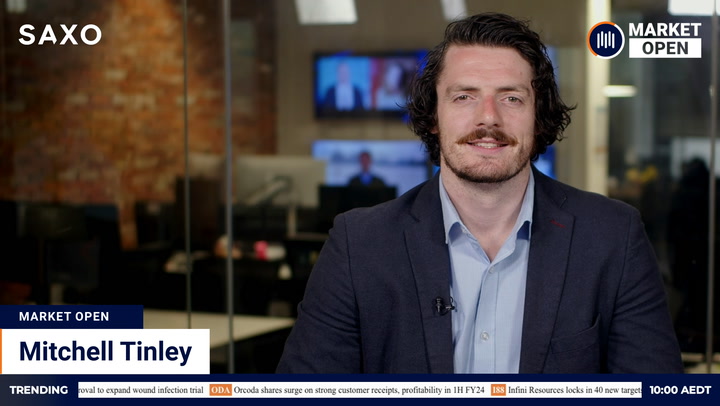The Australian market was poised to open sharply lower after US stocks plunged a day after the biggest rate increase in more than 20 years.
ASX futures dived 113 points or 1.54 per cent as Wall Street erased the previous session’s gains.
The Dow shed more than a thousand points during its worst night since 2020. The Nasdaq Composite lost almost 5 per cent.
The dollar tanked nearly 2 per cent, erasing its biggest gain since the pandemic. Commodity markets avoided the worst of the selling. Iron ore, crude oil, copper and gold advanced.
Wall Street
US stocks erased all of their gains from Wednesday night as investors reassessed the Federal Reserve’s decision to raise its benchmark rate by 50 basis points.
The Dow Jones Industrial Average tumbled 1,063 points or 3.12 per cent to its heaviest loss since October 2020. The S&P 500 shed 153 points or 3.56 per cent. The Nasdaq Composite gave up 647 points or 4.99 per cent.
Wednesday’s relief rally gave way to further selling amid fears a series of rate rises this year will tip the US economy into recession.
“We are still not out of the woods yet, as there is still too much uncertainty over how the Federal Reserve’s actions will tame inflation without causing a recession,” Zach Stein, chief investment officer at the Carbon Collective, told MarketWatch.
The turnaround in sentiment came as bond yields punched to fresh three-and-a-half-year highs. The yield on the ten year treasury traded near 3.1 per cent, sending tremors through pockets of the market whose valuations depend most on future earnings.
“Over the last 15 years since the great financial crisis, economies have slowed once the rate on the 10-year Treasury crossed 3%,” Rhys Williams, chief strategist at Spouting Rock Asset Management, told Investing.com.
“Investors are trying to figure out the proper valuation of the broader stock market, particularly the technology sector, given the Federal Reserve’s withdrawal of stimulus from the economy.”
Companies that released weak earnings guidance during the current reporting season came in for particularly heavy punishment. Amazon tumbled 7.56 per cent, Facebook parent Meta Platforms 6.77 per cent and Netflix 7.69 per cent. Amongst the other tech giants, Apple slumped 5.57 per cent, Microsoft 4.36 per cent and Alphabet 4.71 per cent.
The Nasdaq’s fall was its largest single-day percentage loss since June 2020. The Russell 2000 index of small caps also suffered its worst session since June 2020, shedding 4.04 per cent. The Dow’s loss was the largest since October 2020.
Financial markets have grown increasingly volatile this year as investors struggle with headwinds including soaring inflation, rising rates, war in Ukraine and Covid lockdowns in China. Wall Street’s “fear gauge”, the VIX or Volatility Index jumped almost 23 per cent overnight.
“If you go up 3% and then you give up half a percent the next day, that’s pretty normal stuff… But having the kind of day we had yesterday and then seeing it 100% reversed within half a day is just truly extraordinary,” Randy Frederick, managing director of trading and derivatives at the Schwab Center for Financial Research, told CNBC.
Australian outlook
Batten the hatches. Choppy waters ahead as the market unwinds yesterday’s gains and a fair bit more. A few seasick passengers may consider leaving the ship until it reaches calmer waters.
Market volatility this year is building to an extreme. Essentially, Wall Street had a complete rethink of everything it thought it thought on Wednesday and decided everything it thought it thought was wrong. The rethink overturned equity, bond and currency markets.
The Australian dollar was flipped on its head. The Aussie was lately off 1.9 per cent at 71.13 US cents, back where it was before Wednesday night’s rate hike.
“The Australian dollar, which only yesterday has its best session in over 10 years, erased all of that day’s gains during its worst session in 14 months. That is volatility at its finest,” Matt Simpson, senior market analyst at City Index, said.
“And we may need to get used to it now the Fed are to begin quantitative tightening from June. Given the volatility of the past 48-hours and the weekend looming, many traders will be looking to reduce their risk exposure – whether that be hedging with safe havens or simply moving to cash. Which itself can lead to more erratic moves, so traders would be wise to remain nimble.”
The S&P/ASX 200 jumped 60 points or 0.82 per cent yesterday and will give that back at today’s open. Last week’s six-week low looks likely to come into play if the selling gains momentum.
The US bloodbath was broad enough to encompass all 11 sectors. Declines ranged from 1.07 per cent for the defensive utilities sector up to 5.8 per cent for one of the three “Big Tech” sectors.
The materials sector shed 3.11 per cent, financials 2.91 per cent and industrials 2.66 per cent.
Back home, Macquarie Group releases full-year earnings at 10 am AEST.
A quarterly monetary policy update from the Reserve Bank at 11.30 am will attract more interest than usual following Tuesday’s rate hike. The Australian Industry Group releases a survey of services-sector activity at 8.30 am.
IPOs: the largest float of the year so far takes place at 11.30 am AEST. Chrysos Corporation has raised $180 million to bring its disruptive mining lab technology to market. The company uses X-rays to test drilling samples.
Commodities
Oil shrugged off volatility in other markets, supported by the prospect of a European Union ban on Russian crude imports. Brent crude settled 76 US cents or 0.7 per cent ahead at US$110.90 a barrel.
The gains came as the Organization of the Petroleum Exporting Countries and allies stuck to a previous plan to increase production by 420,000 barrels a day next month. The decision was widely expected as the cartel continued to ignore calls for greater output to rein in prices.
Iron ore rallied after China’s central bank pledged additional support for the economy while it battles Covid lockdowns. The People’s Bank said it would “waste no time planning incremental policy tools to support steady economic growth, stabilise employment and prices… to provide a fair monetary and financial environment.”
The spot price for ore landed in China climbed US$2.40 or 1.7 per cent to US$145.20 a tonne. The most-traded contract on the Dalian Commodity Exchange rallied 1.9 per cent to US$131.74.
BHP and Rio Tinto suffered sharp losses in US action after milder falls in the UK. BHP‘s US-traded depositary receipts dived 5.02 per cent. The miner’s UK stock dipped 0.19 per cent. Rio Tinto shed 3.95 per cent in the US and 0.2 per cent in the UK.
Gold shed much of yesterday’s initial post-Fed gains as the US dollar and bond yields soared, dulling demand for alternative stores of wealth. Metal for June delivery settled US$6.90 or 0.4 per cent higher at US$1,875.70 an ounce after trading above US$1,900. The NYSE Arca Gold Bugs Index slumped 3.32 per cent.
Most industrial metals reversed initial gains as the broader market mood soured. Benchmark copper settled 0.5 per cent ahead on the London Metal Exchange at US$9,512.50 a tonne after being up almost 2 per cent.
Aluminium faded to a loss of 1.2 per cent. Nickel gave up 1.7 per cent, lead 0.5 per cent, zinc 1.6 per cent and tin 0.4 per cent.





